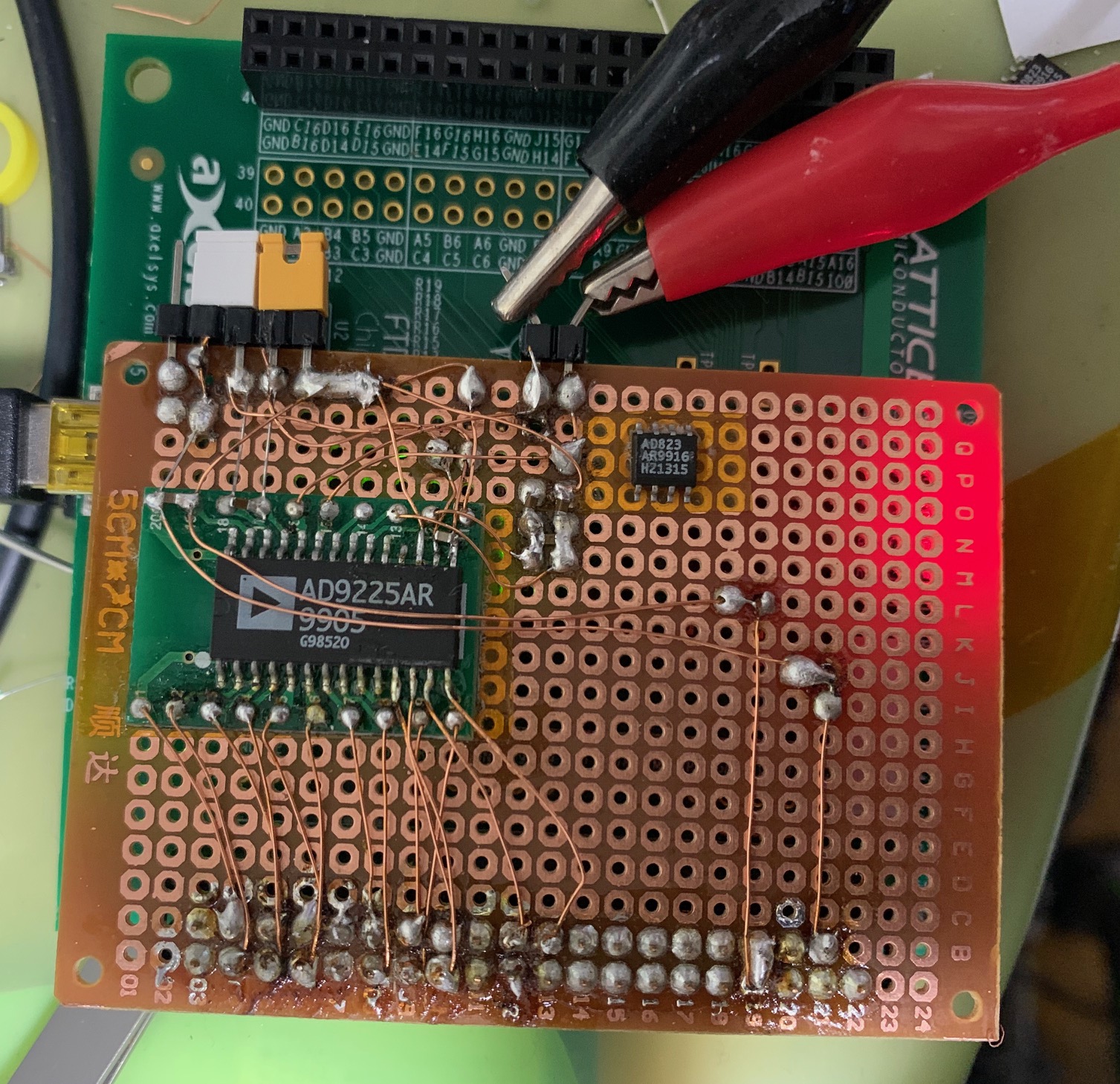Notes on using a ILX511 Linear CCD, AD9225 ADC, ICE40HX8K and Nmigen

The messy pile of hacks above is my first attempt at getting an ILX511 Linear CCD working. I’m using a ICE40HX8K FPGA (Lattice evaluation board). An AD9225 ADC is used to acquire data. An AD823 is used to amplify the signal from the CCD. 2N7002s are used to convert the 3.3v signals to 5v for the CCD. I needed to use 1K pullups to get the required 100ns rise time required…
The horribly filmed scope trace below shows the ROG signal (resets to start of frame) and amplified Vout.
The setup is quite sensitive. I had to use a ND1000 (ND 3.0) in front of the filter. In the video above I’m running a laser pointer back an forth across the CCD, and you can see the peak move relative to the ROG impulse.
The code below is used to drive the CCD. Both the code below and the board are horrible messes. There seem to be a few issues with the code and the output is not as clear as shown in the scope trace. Part of the issue is likely that I’m trying to write data out to the UART as I’m acquiring it. I need to buffer one line (or pixels) and then dump it out to the UART…
But everything more or less works, and it’s probably time to design a PCB if I want to move forward. I’ll then have something stable to work with when rewriting the code. A tarball of the code is here. A listing is also below, it uses the pll code from kbob (modified for the HX8K on the evaluation board) and uart.py from the nmigen repository.
#!/usr/bin/python3
from nmigen import *
from uart import *
from nmigen_boards.ice40_hx8k_b_evn import *
from nmigen.build import *
from pll import PLL
class Top(Elaboratable):
def elaborate(self, platform):
# B1 is clock
adcclk = [ Resource("ad9225clk", 0, Pins("B1", dir="o"), Attrs(IO_STANDARD="SB_LVCMOS")) ]
adc = [ Resource("ad9225", 0, Pins("B2 C1 C2 D1 D2 E2 F1 F2 G2 H1 H2 J2", dir="i"), Attrs(IO_STAN
DARD="SB_LVCMOS")) ]
# pins 3 4 11
ilx511shsw = [ Resource("ilx511shsw", 0, Pins("N3", dir="o"), Attrs(IO_STANDARD="SB_LVCMOS")) ]
ilx511clk = [ Resource("ilx511clk" , 0, Pins("N2", dir="o"), Attrs(IO_STANDARD="SB_LVCMOS")) ]
ilx511rog = [ Resource("ilx511rog" , 0, Pins("M2", dir="o"), Attrs(IO_STANDARD="SB_LVCMOS")) ]
platform.add_resources(adc)
platform.add_resources(adcclk)
platform.add_resources(ilx511shsw)
platform.add_resources(ilx511clk)
platform.add_resources(ilx511rog)
# PLL Stuff
# If you don't specify dir='-', you will experience a world
# of debugging pain.
clk_pin = platform.request(platform.default_clk, dir='-')
m = Module()
pll = PLL(freq_in_mhz=12, freq_out_mhz=24)
m.domains += pll.domain # override the default 'sync' domain
timer = Signal(28)
timerRog = Signal(28)
#Connect TX to B12
led0 = platform.request('led', 0)
muart = platform.request('uart')
data = platform.request('ad9225',0)
dataclk = platform.request('ad9225clk',0)
ccd_shsw = platform.request('ilx511shsw',0)
ccd_clk = platform.request('ilx511clk',0)
ccd_rog = platform.request('ilx511rog',0)
dataA = Signal(8)
rdy = Signal(1)
with m.If(timer[8]): #9
m.d.sync += [
rdy.eq(1),
timer.eq(0)
]
with m.Else():
m.d.sync += [
timer.eq(timer + 1)
]
timerD = Signal(4)
m.d.sync += [
timerD.eq(timerD+1)
]
with m.If(rdy == 1):
m.d.sync += [
rdy.eq(0)
]
with m.If(timerRog[15]): #16
m.d.sync += [
ccd_rog.eq(1),
timerRog.eq(0),
timerD.eq(0),
timer.eq(0),
dataA.eq(0x0A),
rdy.eq(1)
]
with m.Else():
m.d.sync += [
timerRog.eq(timerRog + 1),
dataA.eq(data.i[8:11] + 0x2E),
]
with m.If(timerRog[11]):
m.d.sync += [
ccd_rog.eq(0),
]
with m.If(ccd_rog == 0):
m.d.sync += [
ccd_clk.eq(timerD[-1])
]
with m.Else():
m.d.sync += [
ccd_clk.eq(0)
]
m.d.comb += [
pll.clk_pin.eq(clk_pin),
dataclk.eq(timer[5])
]
m.d.comb += [
ccd_shsw.eq(1) # use Sample and Hold.
]
# UART
uart = UART(divisor=208)
uart.tx_o = muart.tx
m.d.comb += [
uart.tx_data.eq(dataA),
uart.tx_rdy.eq(rdy)
]
m.submodules += [pll, uart]
return m
if __name__ == '__main__':
platform = ICE40HX8KBEVNPlatform()
platform.build(Top(), do_program=True)

